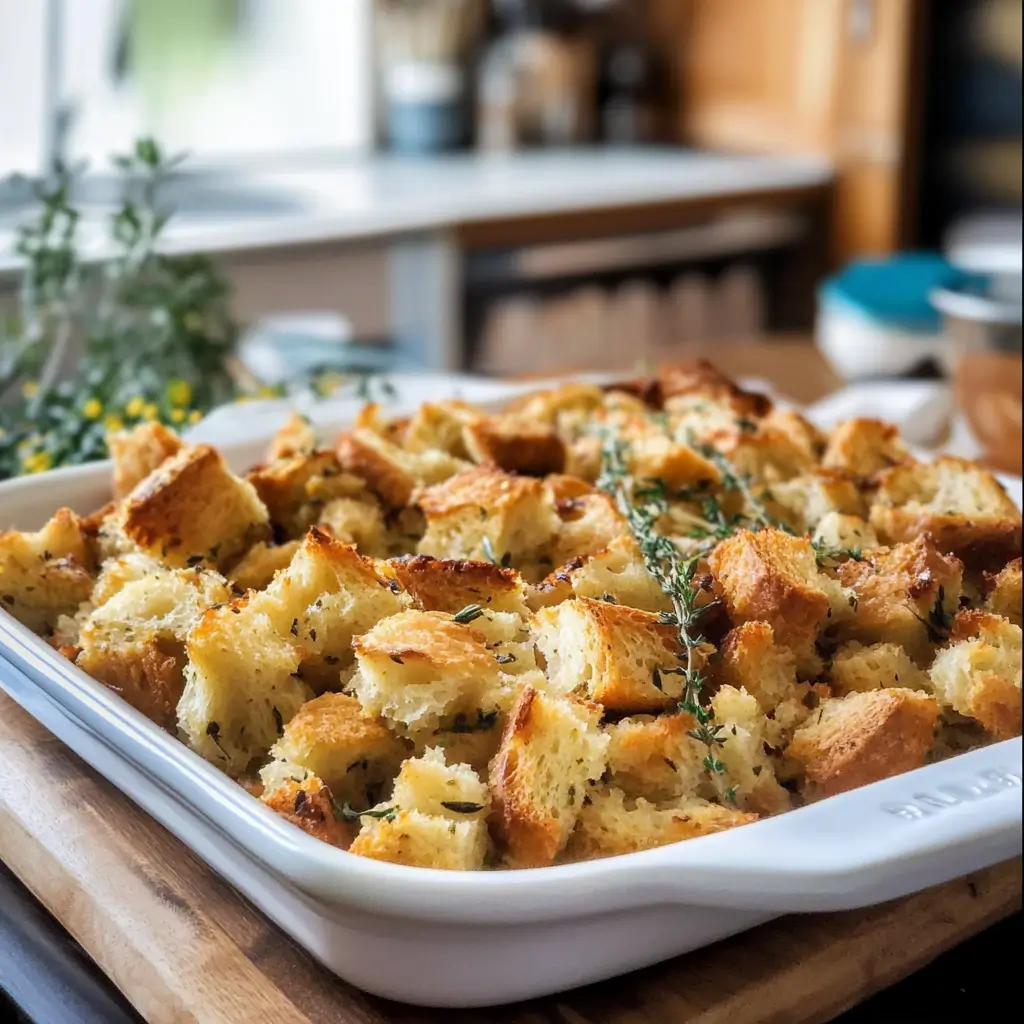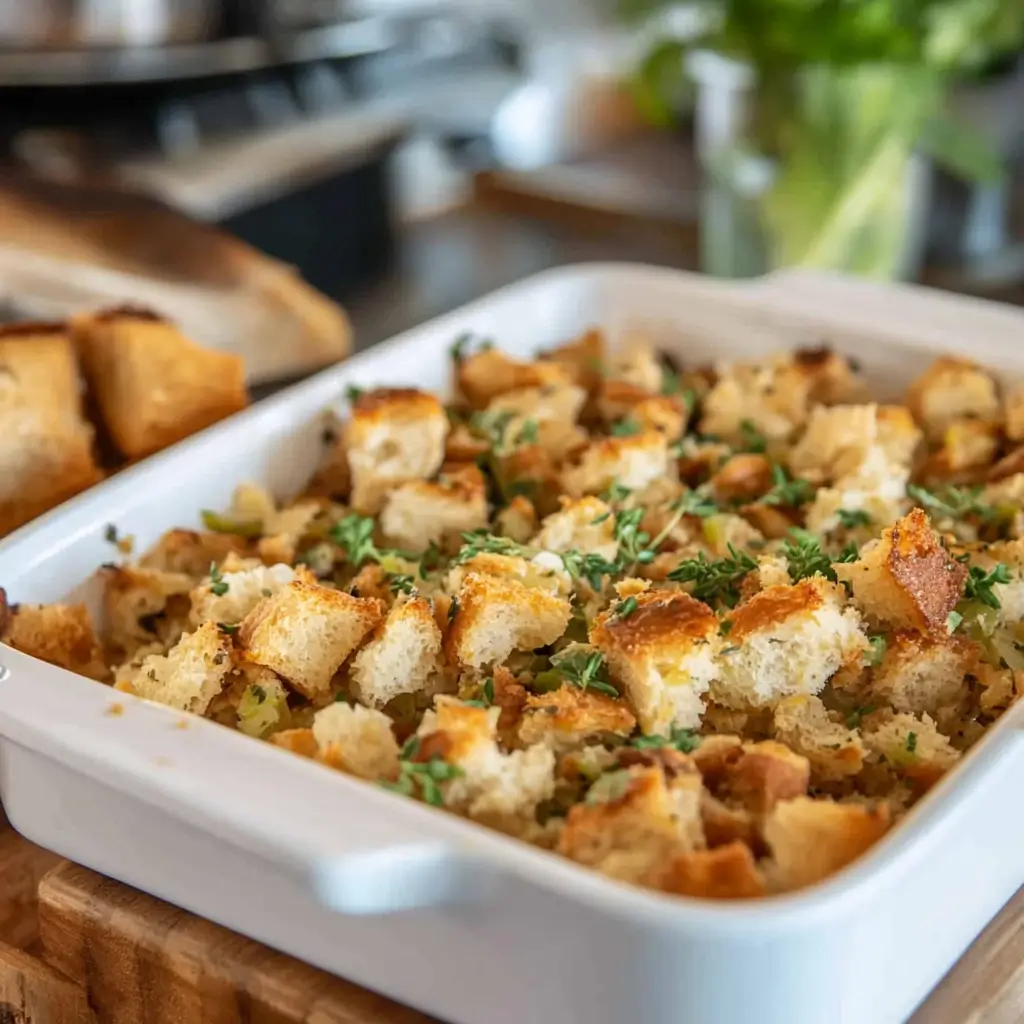The aroma of fresh homemade stuffing with fresh bread baking in the oven is one of the highlights of the holiday season. Whether you’re preparing for Thanksgiving, Christmas, or simply a cozy family dinner, stuffing is a timeless side dish that brings comfort and warmth to the table. In this recipe, we’ll guide you through creating a delicious stuffing made with fresh, soft bread that will surely outshine any store-bought alternatives.
What is Stuffing and Why Use Fresh Bread?
Stuffing, also known as dressing when cooked outside the bird, is a dish made from bread, vegetables, herbs, and liquid. It’s often served alongside roasted meats, particularly turkey, and adds a deliciously savory element to your meal. When prepared with fresh bread, stuffing has a lighter and fluffier texture compared to using pre-dried or cubed bread. The fresh bread absorbs more of the stock and seasonings, leading to a richer flavor and a more satisfying bite.

Benefits of Using Fresh Bread for Stuffing
-
Moisture and Texture: Fresh bread absorbs more liquid, resulting in a stuffing that’s moist and tender, yet still holds its shape.
-
Customizable Flavor: Using fresh bread gives you the ability to choose the type of bread, such as sourdough, French baguette, or hearty white bread, for a more personalized flavor profile.
-
Crispy Top: When baked properly, the stuffing’s top layer becomes beautifully golden and crispy, giving it that perfect contrast of textures.
Essential Ingredients for Homemade Stuffing with Fresh Bread
To make a fantastic homemade stuffing with fresh bread, you’ll need the following ingredients:
-
Fresh Bread: About 1 loaf of any type of bread that you prefer. You can use sourdough, French bread, or even a rustic Italian loaf.
-
Butter: This will help sauté the vegetables and enhance the overall richness of the stuffing.
-
Vegetables: Onions, celery, and garlic form the flavor base for the stuffing.
-
Herbs: Fresh or dried sage, thyme, and rosemary give the stuffing its distinctive earthy flavor.
-
Chicken or Vegetable Stock: A flavorful liquid that helps bind the bread and infuse it with a savory depth.
-
Eggs: These serve as a binder, ensuring that the stuffing holds together and doesn’t fall apart while baking.
-
Salt and Pepper: For seasoning the stuffing to perfection.
Optional add-ins for extra flavor include sausage, cranberries, or pecans.

Tips for Perfect Stuffing Every Time
-
Don’t Overwork the Bread: Tear the bread into cubes or pieces gently to preserve some of the bread’s air pockets, which will help with texture.
-
Add Liquid Gradually: When adding the stock, do it slowly and stir to ensure the bread absorbs enough liquid without becoming too soggy.
-
Use Fresh Herbs: Fresh herbs add a more vibrant flavor to the stuffing, but dried herbs work well if fresh isn’t available.
-
Customize to Your Taste: Don’t hesitate to add your favorite ingredients, like sausage, mushrooms, or dried fruit, for an extra boost of flavor.
The Best Types of Bread for Homemade Stuffing
One of the most important elements of making homemade stuffing with fresh bread is choosing the right type of bread. The bread acts as the base of your stuffing, so its texture and flavor can significantly impact the final result. Here’s a guide to help you select the best bread for your stuffing:
1. Sourdough Bread
Sourdough is an excellent choice for stuffing due to its slightly tangy flavor and hearty texture. It holds up well when soaked with stock and herbs, providing a robust base that complements savory fillings. The tanginess of sourdough adds an extra layer of complexity to your stuffing, making it a standout choice.
2. French Baguette
A French baguette is ideal for a light, airy stuffing. The soft interior of a baguette absorbs the liquid without becoming too soggy, while the crispy crust adds texture. This type of bread gives your stuffing a more refined feel, perfect for an elegant holiday dinner.
3. Hearty White Bread
If you prefer a traditional approach, hearty white bread is a tried-and-true option. It’s neutral in flavor and absorbs the seasonings and stock well, making it an excellent base for a classic stuffing recipe. You can use any sturdy white bread, such as Pepperidge Farm or Wonder Bread.
4. Whole Wheat Bread
For a healthier alternative, whole wheat bread adds a nutty flavor and additional fiber to your stuffing. It’s denser than white bread, so it provides a heartier texture. Whole wheat bread pairs well with earthy ingredients like mushrooms, sage, and sausage.
5. Challah or Brioche
For a richer, slightly sweeter stuffing, challah or brioche bread is a great option. These breads have a light, slightly sweet flavor that complements savory additions like sausage, apples, and cranberries. Brioche, in particular, gives the stuffing a buttery richness that elevates the dish.

Customizing Your Homemade Stuffing with Add-Ins
While homemade stuffing with fresh bread is fantastic on its own, adding extra ingredients can take your stuffing to the next level. Here are some popular add-ins to consider:
1. Sausage
Adding sausage to your stuffing brings richness and depth. You can use Italian sausage, chicken sausage, or any variety you prefer. Crumble the cooked sausage into the stuffing mixture for a meaty, flavorful addition.
2. Dried Fruits
Dried fruits like cranberries, raisins, or apples can add a burst of sweetness to balance the savory flavors. Dried cranberries are particularly popular for holiday stuffing, adding a festive pop of color and tartness.
3. Nuts
Chopped pecans, walnuts, or almonds can add a crunchy texture to your stuffing. The nutty flavor enhances the stuffing and provides a nice contrast to the soft, moist bread.
4. Mushrooms
Mushrooms bring an earthy depth to stuffing. Whether you use cremini, shiitake, or button mushrooms, sautéing them with the onions and celery adds a savory richness. Mushrooms pair well with sage and thyme, making them a great addition to any stuffing recipe.
5. Herbs
While sage, rosemary, and thyme are traditional stuffing herbs, feel free to experiment with other herbs like marjoram or oregano. Fresh herbs provide a vibrant, aromatic flavor that makes your stuffing truly special.
6. Vegetables
Add more flavor and texture by incorporating vegetables like carrots, leeks, or parsnips. These vegetables complement the bread and seasonings, creating a stuffing that’s hearty and satisfying.
How to Store and Reheat Homemade Stuffing
Storing Homemade Stuffing
If you have leftovers or want to make your stuffing ahead of time, it’s easy to store:
-
Refrigeration: Allow the stuffing to cool completely before storing it in an airtight container in the refrigerator for up to 3 days.
-
Freezing: To freeze the stuffing, allow it to cool, then transfer it to a freezer-safe container or bag. Label and store it for up to 3 months. When ready to use, let it thaw in the refrigerator overnight before reheating.
Reheating Homemade Stuffing
To reheat your stuffing, preheat your oven to 350°F (175°C). Place the stuffing in a greased baking dish, cover it with foil, and bake for 20-30 minutes. Remove the foil for the last 5-10 minutes to allow the top to become crispy. If reheating from frozen, add an extra 15-20 minutes to the baking time
FAQs On Homemade Stuffing with Fresh Bread
Is it better to make stuffing with fresh or dry bread?
Making stuffing with fresh bread is generally better because fresh bread absorbs the liquids more evenly, resulting in a moist and flavorful stuffing. However, you can still use dry or stale bread for a slightly firmer texture. Fresh bread gives the stuffing a softer, more tender consistency, while dry bread adds more structure and chewiness. It all depends on your texture preference.
What kind of bread is best for homemade stuffing?
The best bread for homemade stuffing depends on the flavor and texture you prefer. For a classic stuffing, hearty white bread or sourdough are great options. French baguette provides a light, airy stuffing, while whole wheat bread offers a nuttier flavor. You can also experiment with challah or brioche for a richer, slightly sweet stuffing.
Should I put an egg in my stuffing?
Yes, adding egg to your stuffing helps bind the ingredients together, ensuring the stuffing holds its shape while baking. It also adds richness and moisture. The egg gives the stuffing a slightly firmer texture, preventing it from falling apart or becoming too mushy.
What can I use if I don’t have stale bread for stuffing?
If you don’t have stale bread for stuffing, you can easily dry fresh bread in the oven. Simply cut it into cubes and bake at 350°F (175°C) for about 10-15 minutes until the bread is lightly toasted and dry. This will create a similar texture to stale bread, helping it absorb the liquid without becoming soggy.
What makes stuffing taste better?
To make your stuffing taste better, consider the following tips:
-
Use flavorful stock: Turkey stock or chicken stock adds depth and richness to your stuffing.
-
Add herbs and seasonings: Sage, rosemary, and thyme bring an aromatic quality that elevates the flavor.
-
Sauté vegetables: Sautéing onions, celery, and garlic before adding them to the stuffing creates a richer flavor base.
-
Customize with extras: Adding sausage, dried fruit, mushrooms, or nuts can bring extra flavor and texture to your stuffing.

Recipe Card: Homemade Stuffing with Fresh Bread
Ingredients:
-
1 loaf fresh bread (such as sourdough, French bread, or hearty white bread), torn into small cubes
-
1/2 cup unsalted butter
-
1 medium onion, finely chopped
-
2 stalks celery, finely chopped
-
2 cloves garlic, minced
-
2 teaspoons fresh sage, chopped (or 1 teaspoon dried sage)
-
1 teaspoon fresh thyme (or 1/2 teaspoon dried thyme)
-
1 1/2 cups chicken stock (or vegetable stock for a vegetarian version)
-
2 large eggs, beaten
-
1 teaspoon salt (adjust to taste)
-
1/2 teaspoon pepper (adjust to taste)
-
Optional: 1 cup sausage (cooked and crumbled), dried cranberries, or pecans
Instructions:
-
Prepare the Bread: Preheat your oven to 350°F (175°C). Tear the fresh bread into small cubes and spread them evenly on a baking sheet. Toast the bread for 10-15 minutes until slightly crisp, but not browned. Remove from the oven and set aside.
-
Sauté the Vegetables: In a large skillet, melt butter over medium heat. Add the chopped onion, celery, and minced garlic. Sauté for 5-7 minutes until the vegetables are soft and fragrant.
-
Combine the Ingredients: In a large mixing bowl, add the toasted bread cubes, sautéed vegetables, and fresh herbs (sage and thyme). Stir to combine.
-
Add Liquids: Pour in the chicken stock and beaten eggs. Stir everything together until the bread absorbs the stock. Season with salt and pepper to taste. If you’re adding sausage, cranberries, or pecans, mix them in at this point.
-
Bake the Stuffing: Transfer the stuffing mixture into a greased baking dish. Cover the dish with foil and bake for 30 minutes. After 30 minutes, remove the foil and bake for an additional 10-15 minutes until the top is golden brown and crispy.
-
Serve: Let the stuffing rest for a few minutes before serving. Enjoy your delicious homemade stuffing with fresh bread!
Notes:
-
Make Ahead: You can prepare this stuffing a day in advance by assembling everything (up to the baking step) and storing it in the refrigerator. When ready to bake, let it come to room temperature for about 30 minutes before baking as directed.
-
Customizations: Feel free to add other ingredients such as mushrooms, apples, or carrots for a unique twist. You can also make it vegetarian by using vegetable stock and omitting the sausage.
-
Storage: Leftovers can be stored in an airtight container in the refrigerator for up to 3 days. Reheat in the oven at 350°F (175°C) until heated through.
Nutritional Facts (per serving, based on 8 servings):
| Nutrient | Amount per Serving |
|---|---|
| Calories | 250 kcal |
| Carbohydrates | 30g |
| Protein | 6g |
| Fat | 12g |
| Saturated Fat | 7g |
| Cholesterol | 95mg |
| Sodium | 450mg |
| Potassium | 120mg |
| Fiber | 2g |
| Sugar | 3g |
| Vitamin A | 480 IU |
| Vitamin C | 5mg |
| Calcium | 50mg |
| Iron | 1.5mg |
